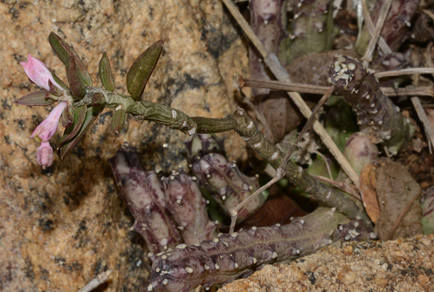Abstract
Euphorbia neorubella is the most highly sought after species in the cultivation of succulent plants. Despite it being often grown by succulent plant collectors and in general horticulture, the species has not been collected from the wild since 1960. This paper reports on the recollection of E. neorubella from its type locality at Mbuinzau Hill in Kenya. The species is illustrated and an amplified description is presented. An identification key with which to separate E. neorubella from its close relatives is presented, and aspects of its distribution, habitat, and phenology are updated. Based on the IUCN Red List Categories and Criteria, the species is considered to be Critically Endangered (CR).
References
- Bally, P.R.O. (1959) Some new species, varieties and forms of Monadenium (Euphorbiaceae). Candollea 17: 25–36. [https://www.e-periodica.ch/digbib/view?pid=can-002%3A1959%3A17#29]
- Bally, P.R.O. (1961) The genus Monadenium. Benteli Publishers, Berne, 111 pp.
- Boissier, E. (1862) Euphorbiaceae subordo I. Euphorbieae. In: De Candolle, A.P. (Ed.) Prodromus systematis naturalis regni vegetabilis, Vol. 15 (2). Victor Mason and Fils, Paris, pp. 3–188. [https://www.biodiversitylibrary.org/item/7166#page/9/mode/1up]
- Bruyns, P.V., Klak, C. & Hanáček, P. (2011) Age and diversity in Old World succulent species of Euphorbia (Euphorbiaceae). Taxon 60 (6): 1717–1733. https://doi.org/10.1002/tax.606016
- Bruyns, P.V., Klak, C. & Hanáček, P. (2017) A revised, phylogenetically-based concept of Ceropegia (Apocynaceae). South African Journal of Botany 112: 399–436. https://doi.org/10.1016/j.sajb.2017.06.021
- Bruyns, P.V., Mapaya, R.J. & Hedderson, T.J. (2006) A new subgeneric classification for Euphorbia (Euphorbiaceae) in southern Africa based on ITS and psbA-trnH sequence data. Taxon 55 (2): 397–420. https://doi.org/10.2307/25065587
- Carter, S. (1987) New taxa and observations in Monadenium (Euphorbiaceae) in East Africa. Kew Bulletin 42 (4): 903–918. https://doi.org/10.2307/4109935
- Carter, S. (1988) Euphorbiaceae Tribe Euphorbieae. In: Polhill, R.M. (Ed.) Flora of Tropical East Africa, Euphorbiaceae (Part 2). A.A. Balkema, Rotterdam, pp. 409–564.
- Carter, S. & Leach, L.C. (2001) Euphorbiaceae Tribe Euphorbieae. In: Pope, G.V. (Ed.) Flora Zambesiaca. Royal Botanic Gardens, Kew, Richmond, pp. 339–465.
- Chapman, P.R. (1972) Monadeniums. The Cactus and Succulent Journal of Great Britain 34 (4): 51–52. [https://www.jstor.org/stable/42785921]
- Croizat, L. (1972) An introduction to the subgeneric classification of Euphorbia L., with stress on the South African and Malagasy species. III. Webbia 27 (1): 1–221. https://doi.org/10.1080/00837792.1972.10669972
- De Jussieu, A.L. (1789) Antonii Laurentii de Jussieu Genera plantarum: secundum dines naturales disposita, juxta methodum in Horto regio parisiensi exaratam, anno M.DCC.LXXIV. Apud Viduam Herissant, Paris & Theophilum Barrois, Toscana, 498 pp. https://doi.org/10.5962/bhl.title.284
- Dorsey, B.L., Haevermans, T., Aubriot, X., Morawetz, J.J., Riina, R., Steinmann, V.W. & Berry, P.E. (2013) Phylogenetics, morphological evolution, and classification of Euphorbia subgenus Euphorbia. Taxon 62 (2): 291–315. https://doi.org/10.12705/622.1
- Haworth, A.H. (1812) Synopsis plantarum succulentarum: cum descriptionibus, synonymis, locis, observationibus anglicanis, culturaque. Richard Taylor Press, London, 207 pp. https://doi.org/10.5962/bhl.title.9462
- Horn, J.W., Van Ee, B.W., Morawetz, J.J., Riina, R., Steinmann, V.W., Berry, P.E. & Wurdack, K.J. (2012) Phylogenetics and the evolution of major structural characters in the giant genus Euphorbia L. (Euphorbiaceae). Molecular Phylogenetics and Evolution 63 (2): 305–326. https://doi.org/10.1016/j.ympev.2011.12.022
- IUCN (2001) IUCN Red List Categories and Criteria, Version 3.1. IUCN Species Survival Commission, Gland and Cambridge, 30 pp.
- Jones, K. & Smith, J.B. (1969) The chromosome identity of Monadenium Pax and Synadenium Pax (Euphorbiaceae). Kew Bulletin 23 (3): 491–498. https://doi.org/10.2307/4117196
- Leach, L.C. (1973) New and interesting taxa of the tribe Euphorbieae (Euphorbiaceae) from Portuguese Africa. Garcia de Orta, Serie de Botanica 1 (1): 31–42.
- Linnaeus, C. (1753) Species Plantarum, Vol. 1. Laurentius Salvius, Stockholm, 560 pp. https://doi.org/10.5962/bhl.title.669
- Pax, F.A. (1894) Euphorbiaceae africanae. II. In: Engler, A. (Ed.) Beiträge zur Flora von Afrika. VIII. Botanische Jahrbücher fur Systematik, Pflanzengeschichte und Pflanzengeographie 19: 76–127. [https://www.biodiversitylibrary.org/item/677#page/82/mode/1up]
- Pax, F.A. (1903) Euphorbiaceae africanae VI. In: Engler, A. (Ed.) Beiträge zur Flora von Afrika. XXIV. Botanische Jahrbücher für Systematik, Pflanzengeschichte und Pflanzengeographie 33: 276–291. [https://www.biodiversitylibrary.org/page/213096#page/287/mode/1up]
- Pritchard, A. (2010) Monadenium. Cactus & Company, Italy, 109 pp.
- Steinmann, V.W. & Porter, J.M. (2002) Phylogenetic relationships in Euphorbieae (Euphorbiaceae) based on ITS and ndhF sequence data. Annals of the Missouri Botanical Garden 89 (4): 453–490. https://doi.org/10.2307/3298591
- Thiers, B. (2024, onwards) Index herbariorum: a global directory of public herbaria and associated staff. New York Botanical Garden’s Virtual Herbarium. Available from: http://sweetgum.nybg.org/science/ih/ (accessed 30 May 2024)
- Webster, G.L. (1967) The genera of Euphorbiaceae in the southeastern United States. Journal of the Arnold Arboretum 48 (4): 363–430. [https://www.jstor.org/stable/43782494]
- Webster, G.L. (2014) Euphorbiaceae. In: Kubitzki, K. (Ed.) The Families and Genera of Vascular Plants, Vol. X1: Flowering Plants. Eudicots, Malpighiales. Springer Verlag, Berlin, pp. 51–216. https://doi.org/10.1007/978-3-642-39417-1_10
- Wei, N., Pérez-Escobar, O.A., Musili, P.M., Huang, W.C., Yang, J.B., Hu, A.Q., Hu, G.W., Grace, O.M. & Wang, Q.F. (2021a) Plastome evolution in the hyperdiverse genus Euphorbia (Euphorbiaceae) using phylogenomic and comparative analyses: Large-scale expansion and contraction of the inverted repeat region. Frontiers in Plant Science 12: a712064. https://doi.org/10.3389/fpls.2021.712064
- Wei, N., Mutie, F.M., Mwachala, G., Grace, O.M., Hu, G.W. & Wang, Q.F. (2021b) Euphorbia mbuinzauensis, a new succulent species in Kenya from the Synadenium group in Euphorbia sect. Monadenium (Euphorbiaceae). PhytoKeys 183: 21–35. https://doi.org/10.3897/phytokeys.183.70285
- Zimmermann, N.F.A., Ritz, C.M. & Hellwig, F.H. (2010) Further support for the phylogenetic relationships within Euphorbia L. (Euphorbiaceae) from nrITS and trnL–trnF IGS sequence data. Plant Systematics and Evolution 286 (1–2): 39–58. https://doi.org/10.1007/s00606-010-0272-7


